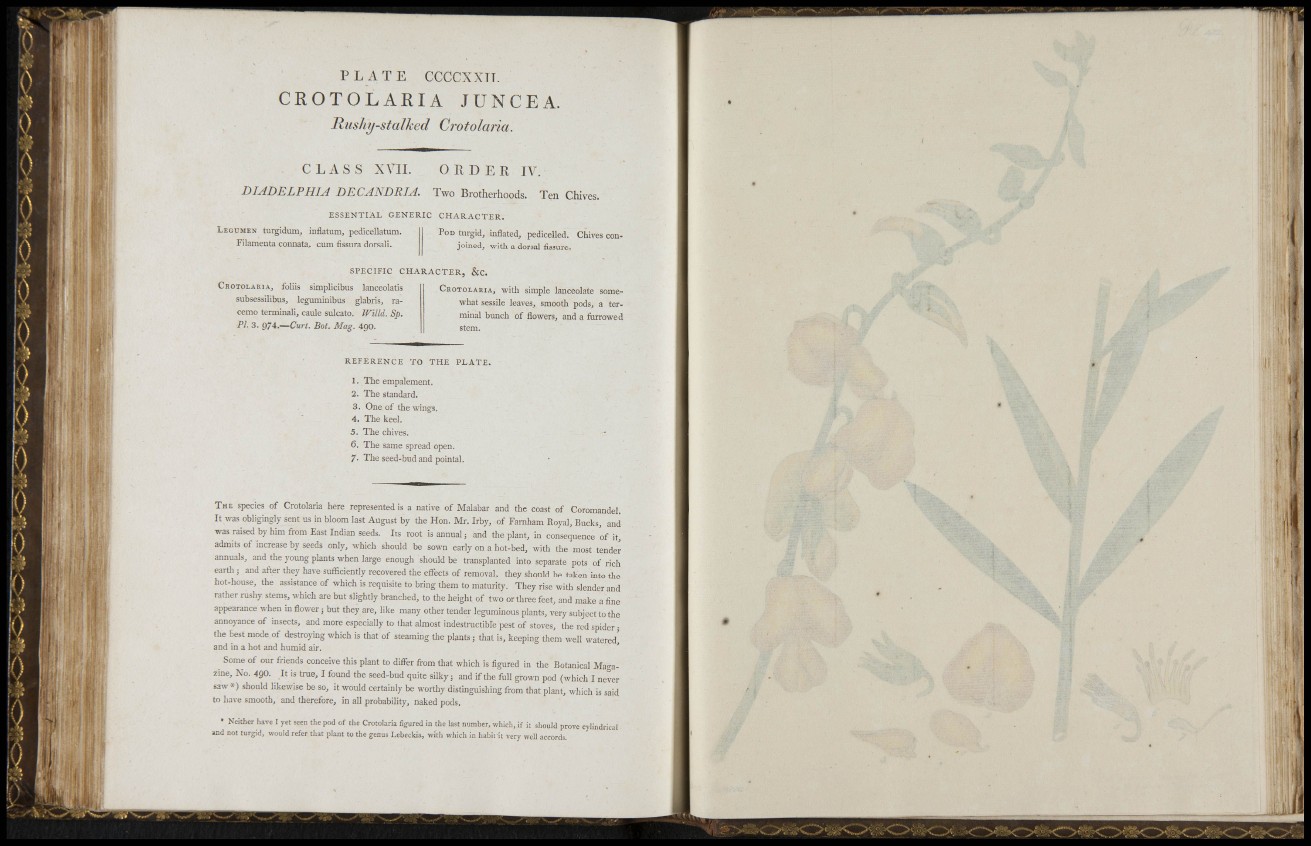
... t
f ; .
r -
it
,,vi I
i ,.„
H i
| | ] r ' l i i ¡ m
, , i S f I y :
. 'T ; -,
(IB i"
' ¡i: " .•
• i l -
P L A T E CC C C X X I I .
C R O T O L A R I A JUNCEA.
R i ( s / i i f - s t a l l - e d Crotolaria.
C L A S S X n L O R D E R IV.
DI AD E LP HI A DECANDRIA. Two Brotherhoods. Ten Chives.
ESSENTIAL GENERIC CHARACTER.
LEGUMEN turgidunij iiiflatum, pedicellatum.
Filamenta connata^ cum fissura dorsali.
POD turgid, inflated, pedicelled. Chives conjoined,
witli a dorsal fissure.
SPECIFIC CHARACTER, &c.
CROTOLARIA, foliis simplicibus lanceolatis
subsessilibus, leguminibus glabris, racemo
terminali, caule solcato. TFilld. Sp.
Pi. 3. Q^i.—Curt. Boi. Mag. 49O.
CEOTOLARIA, witli simple lanceolate somewhat
sessile leaves, smootli pods, a terminal
bunch of flowers, and a farrowed
stem.
REFERENCE TO THE PLATE.
1. The empalement.
2. The standard.
3. One of the wings.
4 . The keel.
5. The chives.
6. The same spread open.
7. The seed-bud and pointal.
THE species of Crotolaria here represented is a native of Malabar and the coast of Coromandel.
I t was obligingly sent us in bloom last August by the Hon. Mr. Irby, of Farnliam Royal, Bucks, and
was raised by him from East Indian seeds. Its root is annual ; and the plant, in consequence of it,
admits of increase by seeds only, which should be sown early on a hot-bed, with the most tendei
annuals, and the young plants when large enough should be transplanted into separate pots of rich
earth ; and after they have sufficiently recovered the effects of removal, they should be taken into the
hot-house, the assistance of which is requisite to bring them to maturity. They rise with slender and
rather rushy stems, which are but slightly branched, to the height of two or three feet , and make a fine
appearance i^-hen in flower; but they are, like many other tender leguminous plants, very subject to the
anno)-ance of insects, and more especially to that almost indestructible pest of stoves, the red spider;
the best mode of destrojnng which is that of steaming the plants; that is, keeping them well watered^
and in a hot and humi d air.
Some of our friends conceive this plant to difi^er f rom that which is figured in the Botanical Magazine,
No. 490. It is true, I found the seed-bud quite silky; and if the full grown pod (which I never
s a w * ) should likewise be so, it would certainly be worthy distinguishing from that plant, which is said
to have smooth, and therefore, in all probability, naked pods.
• Neither have I yet seen the pod of the Crotolaria fig^ured in the last number, which, if it should prove cylindrical
and not turgid, would refer that plant to the genus Lebeckia, with which in habi f i t very well accords.
i ; f : r i
%
•J
1 ]'
•• ì
I :
: i;«
S
> m < >